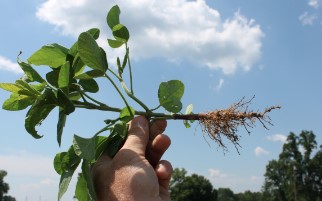By David Holshouser
For greater soybean yields, one of the best things that you can do is walk your fields. Many problems reveal themselves during the summer. Actions taken or not taken can be very noticeable. By walking fields, we can see what’s working and what’s not working. Certain problems can be solved, some cannot. For those that cannot be solved this year, we can do better next season by understanding why we have the problem. Therefore, a review of how to diagnose your crop will likely beneficial.
A few years ago, I published “Troubleshooting The Soybean Crop“. Although a little dated, most of the information is still good. This publication will guide you through how to go about diagnosing problems, includes a vegetative- and reproductive-stage outline with lots of photos, and also includes a sample crop scouting and diagnostic form. You can download a view a PDF copy, or contact me – I still have a few hard copies left. By following some general guidelines, one can become quite good at diagnosing problems. Below is a summary.
First, document everything! Memories tend to fade. We often forget or overlook details. You can document by taken notes (many phone apps or iPad/tablets work well for this). Make a recording. Take pictures – this is especially useful when you need help – and send those photos to others.
PRELIMINARY FACT FINDING. You can obtain plenty of information before you even get to the field. Although I call this preliminary (as if you’ve not seen the problem), you may need to go back to the office to refresh your memory of what you did. Information that can be acquired beforehand or back in the office includes:
- Cropping History
- Equipment
- Soil Information
- Weather
- Pest Management Information
- Tillage and Other Cultural Practices

THE FIELD VISIT
- Take all materials and equipment needed (e.g., phones, paper, shovel, plastic bags, soil probes, etc.)
- Windshield/Whole Field Investigation
- Above-Ground Inspection
- Take Appropriate Plant or Soil Samples
- Equipment Check
- Interaction with Others
- Document Everything!
ANALYSIS OF DATA AND FINDINGS
- Patterns
- Look-Alike Symptoms
- Interacting Factors/More Than One Problem
DRAWING A CONCLUSION. Review the facts and data. Eliminate unlikely causes. Validate likely causes. You may be able to drawn a conclusion in the field, but lab analysis may be needed.